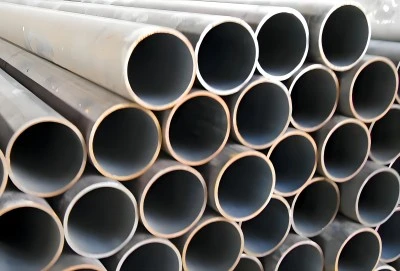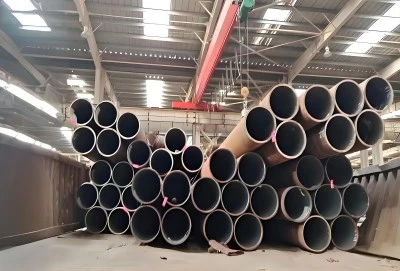When it comes to steel pipes, understanding the differences between ASTM A500 and ASTM A53 is crucial for engineers and project managers in the oil and gas, construction, and industrial sectors. While both standards are widely used, they serve distinct purposes. A500 Gr B pipe, for instance, is primarily designed for structural applications, offering high strength and weldability. On the other hand, ASTM A53 pipes are often preferred for fluid transport systems. The key distinctions lie in their chemical composition, manufacturing processes, and mechanical properties, which we'll explore in detail throughout this article.
|
|
|
Composition Variations: A500 vs A53 Steel
1.Chemical makeup: Key differences in A500 and A53 alloys
The chemical composition of ASTM A500 and ASTM A53 steel pipes plays a significant role in their performance characteristics. A500 steel, particularly A500 Gr B pipe, typically contains higher levels of manganese and silicon compared to A53. These elements contribute to increased strength and improved weldability, making A500 pipes ideal for structural applications.
In contrast, ASTM A53 steel has a more balanced composition, with controlled levels of carbon, manganese, phosphorus, and sulfur. This formulation enhances its resistance to corrosion and makes it suitable for fluid transport applications. The careful adjustment of these elements ensures that A53 pipes maintain their integrity under various pressure and temperature conditions.
2.Manufacturing processes: Seamless vs welded options
The manufacturing processes for ASTM A500 and ASTM A53 pipes differ significantly, influencing their final properties and applications. A500 pipes are typically produced using the electric resistance welding (ERW) method, which creates a strong, continuous weld along the length of the pipe. This process results in uniform wall thickness and excellent straightness, crucial factors for structural applications.
ASTM A53 pipes, however, offer more versatility in manufacturing options. They can be produced as seamless pipes, formed through extrusion without any welding, or as welded pipes using various welding techniques. This flexibility allows for a wider range of sizes and wall thicknesses, catering to diverse fluid transport needs across industries.
3.Carbon content impact on A500 and A53 performance
The carbon content in ASTM A500 and ASTM A53 steels significantly influences their performance characteristics. A500 Gr B pipe typically has a higher carbon content, which contributes to its superior strength and hardness. This makes it an excellent choice for load-bearing structures in construction and industrial applications.
ASTM A53 pipes generally have a lower carbon content, enhancing their ductility and formability. This property is particularly advantageous in piping systems that may experience thermal expansion or require bending during installation. The lower carbon content also improves the pipe's resistance to brittle fracture, a critical factor in low-temperature environments.
Application Suitability: ASTM A500 or A53?
A500 in structural applications: Bridges and buildingsASTM A500 pipes, especially A500 Gr B pipe, excel in structural applications due to their high strength-to-weight ratio and excellent weldability. In bridge construction, these pipes are often used as support columns, truss members, and in the framework of pedestrian walkways. Their ability to withstand heavy loads while maintaining structural integrity makes them a preferred choice for engineers working on complex bridge designs.
In building construction, A500 pipes find extensive use in various structural elements. They serve as vertical columns in high-rise buildings, providing the necessary support to withstand wind loads and seismic forces. Additionally, these pipes are commonly used in the framing of large industrial warehouses, sports stadiums, and airport terminals, where long spans and high strength are required.
A53 for fluid transport: Pressure and temperature ranges
ASTM A53 pipes are specifically designed for fluid transport applications, making them ideal for various piping systems. These pipes can handle a wide range of pressures and temperatures, making them suitable for both low and high-pressure systems. In oil and gas pipelines, A53 pipes are used for transporting crude oil, natural gas, and refined petroleum products over long distances.
The corrosion resistance of A53 pipes also makes them suitable for water supply systems in urban infrastructure. They can withstand the varying pressures and chemical treatments often used in municipal water distribution networks. Moreover, their ability to maintain integrity at elevated temperatures makes them suitable for steam pipelines in power plants and industrial facilities.
Industry-specific uses: Oil & gas vs construction
In the oil and gas industry, both ASTM A500 and A53 pipes have distinct roles. A500 Gr B pipe is often used in offshore platform construction, providing structural support for drilling rigs and production facilities. Its high strength and resistance to fatigue make it ideal for withstanding the harsh marine environment and dynamic loads experienced in offshore operations.
ASTM A53 pipes, on the other hand, are extensively used in the transportation of oil and gas products. They form the backbone of gathering systems in oil fields, transmission pipelines across continents, and distribution networks in urban areas. Their versatility allows them to be used in both onshore and offshore applications, handling the diverse pressure and temperature requirements of different hydrocarbon products.
In the construction industry, A500 pipes dominate in structural applications, while A53 pipes are more commonly found in building services. A500 pipes are used in the primary structure of buildings, providing the main load-bearing elements. A53 pipes are typically employed in fire protection systems, HVAC ducting, and plumbing networks within buildings.
Mechanical Properties Comparison: A500 and A53
Tensile strength: A500 vs A53 grade variationsWhen comparing the tensile strength of ASTM A500 and ASTM A53 pipes, it's essential to consider the various grades within each standard. A500 Gr B pipe, for instance, offers higher tensile strength compared to most A53 grades. This superior strength makes A500 pipes the preferred choice for structural applications where load-bearing capacity is crucial.
ASTM A500 Grade B typically has a minimum tensile strength of 58,000 psi (400 MPa), while ASTM A53 Grade B has a minimum tensile strength of 60,000 psi (415 MPa). However, it's important to note that A500 pipes are available in higher grades, such as Grade C, which can offer even greater tensile strength, reaching up to 62,000 psi (427 MPa).
Yield strength analysis: Which pipe excels under stress?
Yield strength is a critical factor in determining a pipe's performance under stress. A500 Gr B pipe generally exhibits higher yield strength compared to A53 pipes, making it more resistant to permanent deformation under load. This property is particularly valuable in structural applications where maintaining shape and integrity under varying loads is essential.
ASTM A500 Grade B has a minimum yield strength of 42,000 psi (290 MPa), while ASTM A53 Grade B has a minimum yield strength of 35,000 psi (240 MPa). This difference in yield strength highlights why A500 pipes are often preferred in construction projects that require high load-bearing capacity and resistance to structural deformation.
Weldability factors: A500 and A53 in fabrication
Weldability is a crucial consideration in the fabrication and installation of steel pipes. Both ASTM A500 and A53 pipes are known for their good weldability, but there are some differences to consider. A500 pipes, including A500 Gr B pipe, are specifically designed with weldability in mind, making them ideal for structural applications that require extensive welding during assembly.
The controlled chemical composition of A500 pipes, particularly the balanced carbon equivalent, contributes to their excellent weldability. This characteristic allows for strong, reliable welds with minimal risk of cracking or other weld-related defects. In contrast, while A53 pipes are also weldable, they may require more careful control of welding parameters, especially in thicker wall sections, to ensure optimal weld quality.
For fabricators and welders, the choice between A500 and A53 pipes often comes down to the specific requirements of the project. A500 pipes are generally preferred in structural fabrication where multiple welded connections are necessary, while A53 pipes are more commonly used in piping systems where welding may be less frequent but still important for joining pipe sections and fittings.
In conclusion, the choice between ASTM A500 and ASTM A53 pipes depends on the specific requirements of your project. A500 Gr B pipe excels in structural applications, offering high strength and excellent weldability, making it ideal for construction projects. ASTM A53 pipes, with their versatility in fluid transport and corrosion resistance, are better suited for piping systems in various industries. Understanding these differences is crucial for engineers and project managers to make informed decisions, ensuring the right pipe is used for the right application, ultimately contributing to the safety, efficiency, and longevity of their projects.
ASTM A500 Gr B Pipe For Sale
For high-quality ASTM A500 and A53 pipes, including Gr B pipe, Hebei Longma Group is your trusted source. With advanced production equipment imported from Germany and independently developed technologies, we ensure superior product quality. Our professional team of over 300 employees, including 60+ technical experts, guarantees excellence in every pipe we manufacture. Comprehensive testing facilities, including ultrasonic flaw detectors and X-ray equipment, ensure product integrity. We offer fast delivery, with standard thickness pipes ready in as little as 7 days. Our complete certification, including API 5L and ISO 9001, demonstrates our commitment to quality. Thanks to our efficient production model and strong supplier relationships, we offer competitive pricing without compromising on quality. For more information or to place an order, contact us at info@longma-group.com.














